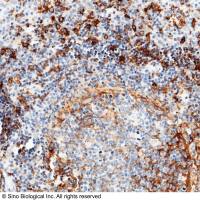Use of the Polymerase Chain Reaction Technique to Detect the t(14;18) Translocation in Lymphoid Tissue
互联网
互联网
相关产品推荐

IKZF1/IKZF1蛋白Recombinant Human DNA-binding protein Ikaros (IKZF1)重组蛋白Ikaros family zinc finger protein 1 (Lymphoid transcription factor LyF-1) (IK1) (IKAROS) (LYF1) (ZNFN1A1)蛋白
¥1836

Coagulation Factor III / Tissue Factor / CD142 鼠单抗 (FITC)
¥700

BRDU LABEL.AND DETECT.KIT III
¥1

CD14 Antibody, Rabbit MAb | CD14 兔单抗
¥800

Recombinant-Synechococcus-elongatus-Photosystem-II-44-kDa-reaction-center-proteinpsbCPhotosystem II 44 kDa reaction center protein Alternative name(s): PSII 43 kDa protein Protein CP-43 Protein P6
¥12880
相关问答

